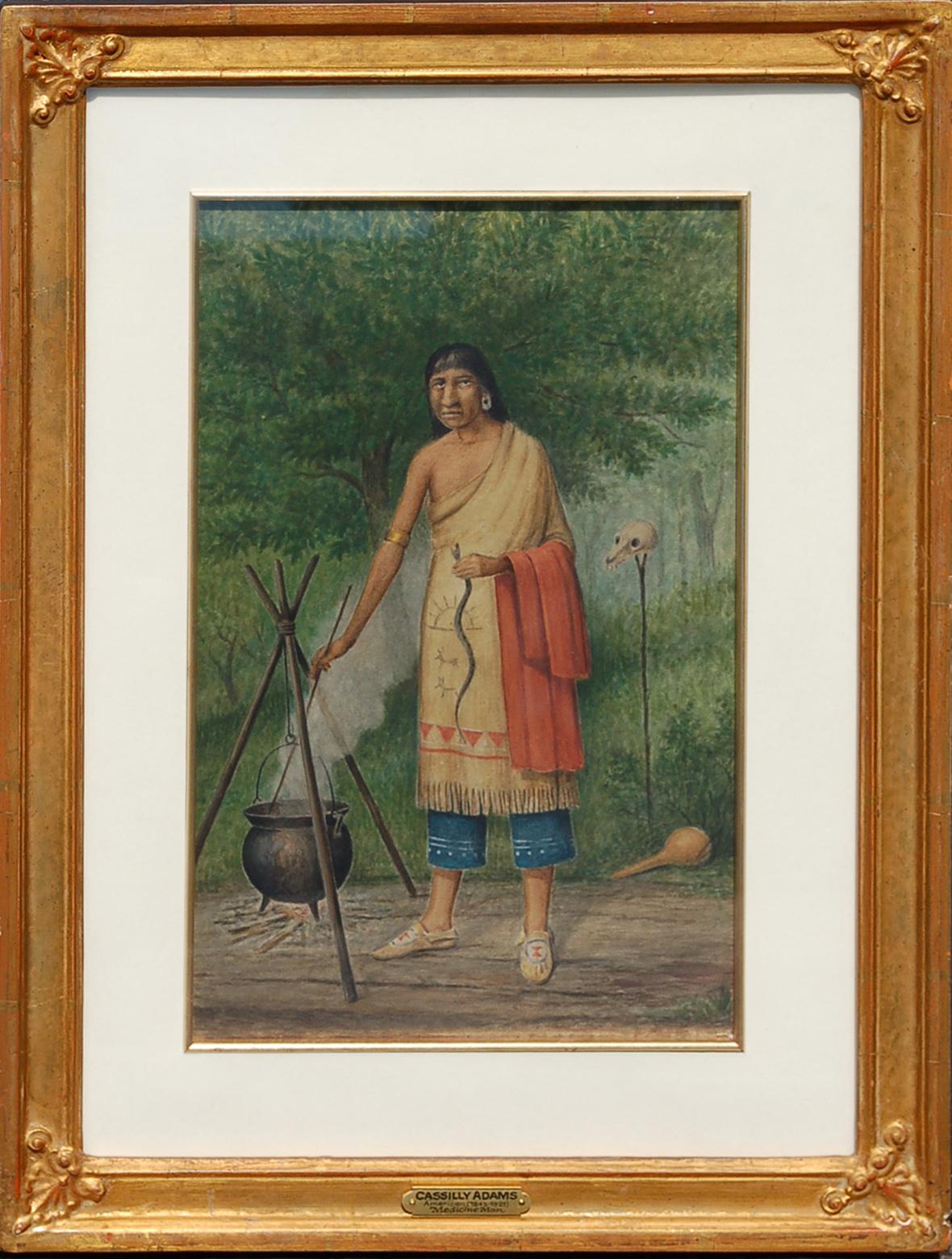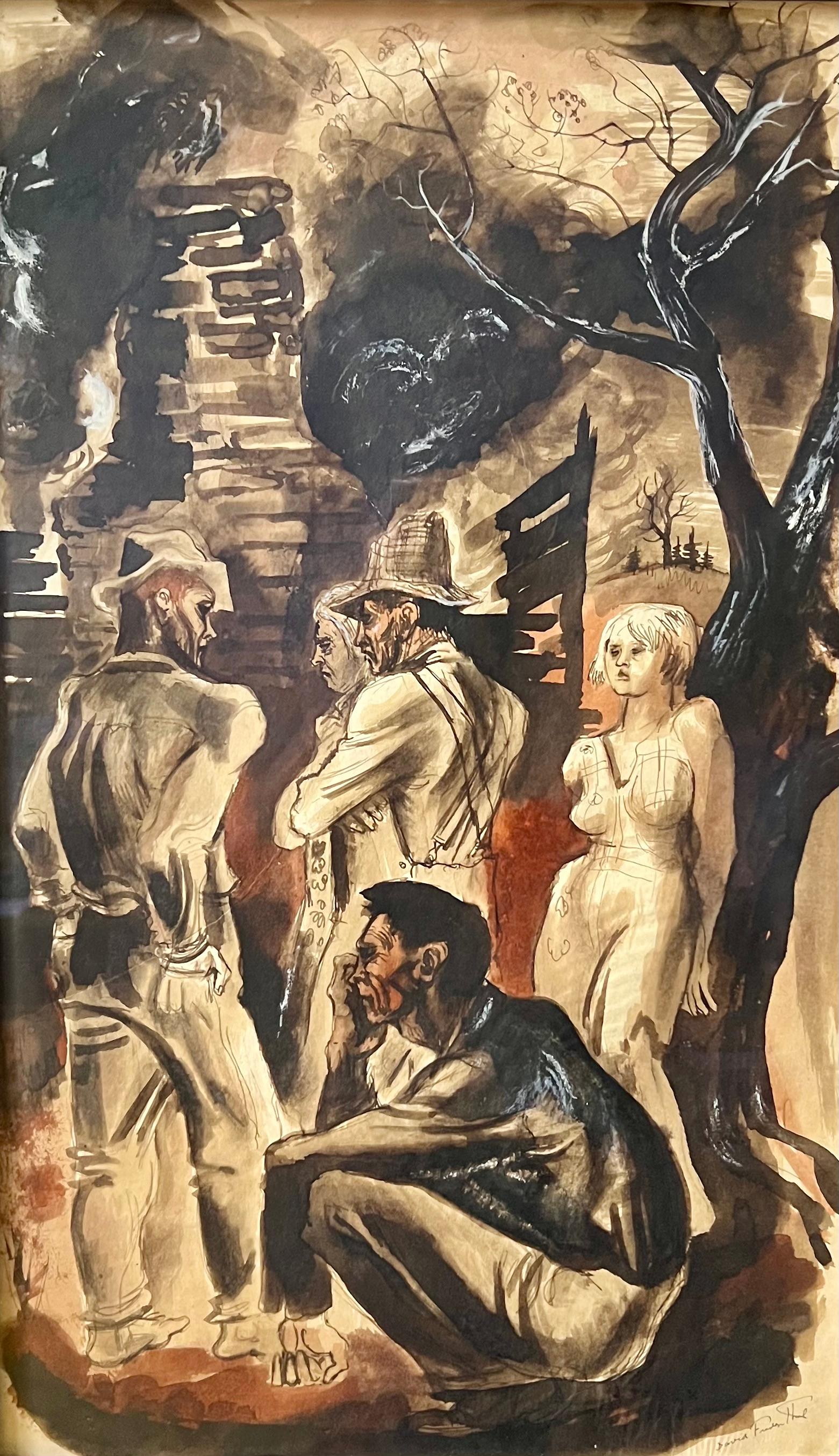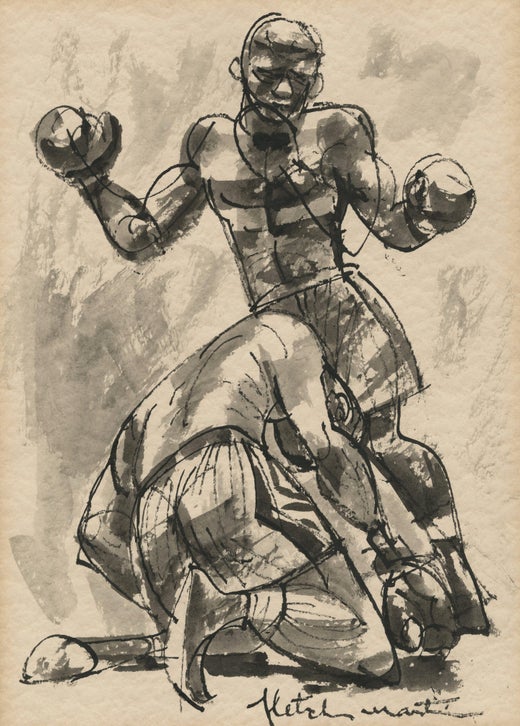Fletcher Martin"Sleigh Ride, Winter, " Fletcher Martin, Woodstock, Holiday Scene Illustrationcirca 1955
circa 1955
About the Item
- Creator:Fletcher Martin (1904-1979, American)
- Creation Year:circa 1955
- Dimensions:Height: 23.5 in (59.69 cm)Width: 19.5 in (49.53 cm)
- Medium:
- Movement & Style:
- Period:
- Condition:Excellent.
- Gallery Location:New York, NY
- Reference Number:1stDibs: LU184129904642
Fletcher Martin
Fletcher Martin was an American painter, illustrator, muralist and educator. He is best known for his images of military life during World War II and his sometimes brutal images of boxing and other sports. Martin was born in 1904 in Palisade, Colorado, one of seven children of newspaperman Clinton Martin and his wife Josephine. The family relocated to Idaho and later Washington. By the age of 12, he was working as a printer. He dropped out of high school and held odd jobs such as lumberjack and professional boxer. He served in the U.S. Navy, 1922–26. Martin's artistic skills were largely self-taught.
- ShippingRetrieving quote...Ships From: New York, NY
- Return PolicyA return for this item may be initiated within 3 days of delivery.
- Out of the Sun (Under the Racetrack Grandstand), Saratoga Springs, Anne DiggoryBy Anne DiggoryLocated in New York, NYAnne Diggory (b. 1951) Out of the Sun (Under the Racetrack Grandstand), 1978 Watercolor on paper 7 x 10 inches Signed and dated lower left Provenance: Ac...Category
1970s Contemporary Landscape Drawings and Watercolors
MaterialsPaper, Watercolor, Pencil
- Five at the Rail, View of Racetrack and Crowd, Saratoga Springs, New YorkBy Anne DiggoryLocated in New York, NYAnne Diggory (b. 1951) Five at the Rail, Saratoga Springs Racecourse, New York, circa 1978 Watercolor on paper 4 3/4 x 6 inches Initialed lower right: Dig...Category
1970s Contemporary Landscape Drawings and Watercolors
MaterialsWatercolor, Paper
- "Medieval Thoughts, Prague, " Alphonse Mucha, Czech Art Nouveau IllustrationBy Alphonse MuchaLocated in New York, NYAlphonse Mucha (Czech, 1860 - 1939) Medieval Thoughts, circa 1890 Wash, ink, and watercolor on paper 11 x 9 inches Signed lower right Provenance: Phillips New York, 19th and 20th ce...Category
1890s Art Nouveau Figurative Drawings and Watercolors
MaterialsWatercolor, Ink, Paper
- "Afternoon Sun, " Ann Wyeth McCoy, Interior and LandscapeLocated in New York, NYAnn Wyeth McCoy (1915 - 2005) Afternoon Sun Watercolor on paper Sheet 24 x 18 inches Signed lower left Provenance: Somerville Manning Gallery Private ...Category
20th Century American Realist Landscape Drawings and Watercolors
MaterialsWatercolor, Paper
- "The Red Silo" Winold Reiss, Rural Regionalist Landscape, Sunny Day on FarmBy Winold ReissLocated in New York, NYWinold Reiss The Red Silo Signed lower left Watercolor on paper 20 x 29 inches Winold Reiss (1886-1953) was an artist and designer who emigrated to the United States from Germany in 1913. Probably best known as a portraitist, Reiss was a pioneer of modernism and well known for his brilliant work in graphic and interior design. A compassionate man who greatly respected all people as human beings, he believed that his art could help break down racial prejudices. Like his father Fritz Reiss (1857-1915), who was also an artist and who was his son's first teacher, Winold Reiss was artistically moved by diverse cultures. The elder Reiss focused on folk life in Germany while Winold drew substantial inspiration from a range of cultures, particularly Native American, Mexican, and African-American. As did many young aspiring artists, Winold Reiss studied with the esteemed painter and teacher Franz von Stuck at the Royal Academy of Fine Arts in Munich, which was at that time a center of the decorative and fine-arts movement. It is not known whether Reiss met E. Martin Hennings...Category
Mid-20th Century American Realist Landscape Drawings and Watercolors
MaterialsPaper, Watercolor
- "Lobstermen in Gloucester, Mass." Lionel Reiss WPA Social Realism FishermenBy Lionel S. ReissLocated in New York, NYLionel S. Reiss (1894 - 1988) Lobstermen in Gloucester, Massachusetts, circa 1943 Watercolor on paper Sight 17 1/2 x 23 inches Signed lower left Provenance: Private Collection, Las Vegas, Nevada In describing his own style, Lionel Reiss wrote, “By nature, inclination, and training, I have long since recognized the fact that...I belong to the category of those who can only gladly affirm the reality of the world I live in.” Reiss’s subject matter was wide-ranging, including gritty New York scenes, landscapes of bucolic Bucks County, Pennsylvania, and seascapes around Gloucester, Massachusetts. However, it was as a painter of Jewish life—both in Israel and in Europe before World War II—that Reiss excelled. I.B. Singer, the Nobel Prize winner for Literature, noted that Reiss was “essentially an artist of the nineteenth century, and because of this he had the power and the courage to tell visually the story of a people.” Although Reiss was born in Jaroslaw, Poland, his family immigrated to the United States in 1898 when he was four years old. Reiss's family settled on New York City’s Lower East Side and he lived in the city for most of his life. Reiss attended the Art Students League and then worked as a commercial artist for newspapers and publishers. As art director for Metro-Goldwyn-Mayer, he supposedly created the studio’s famous lion logo. After World War I, Reiss became fascinated with Jewish life in the ‘Old World.’ In 1921 he left his advertising work and spent the next ten years traveling in Europe, the Middle East, and North Africa. Like noted Jewish photographers Alter Kacyzne and Roman Vishniac, Reiss depicted Jewish life in Poland prior to World War II. He later wrote, “My trip encompassed three main objectives: to make ethnic studies of Jewish types wherever I traveled; to paint and draw Jewish life, as I saw it and felt it, in all aspects; and to round out my work in Israel.” In Europe, Reiss recorded quotidian scenes in a variety of media and different settings such as Paris, Amsterdam, the Venice ghetto, the Jewish cemetery in Prague, and an array of shops, synagogues, streets, and marketplaces in the Jewish quarters of Warsaw, Lodz, Krakow, Lublin, Vilna, Ternopil, and Kovno. He paid great attention to details of dress, hair, and facial features, and his work became noted for its descriptive quality. A selection of Reiss’s portraits appeared in 1938 in his book My Models Were Jews. In this book, published on the eve of the Holocaust, Reiss argued that there was “no such thing as a ‘Jewish race’.” Instead, he claimed that the Jewish people were a cultural group with a great deal of diversity within and between Jewish communities around the world. Franz Boas...Category
1940s American Realist Landscape Paintings
MaterialsPaper, Watercolor
- Large Watercolour of Pleasure Boats Moored on the River in Florida by USA ArtistLocated in Preston, GBLarge Watercolour of Pleasure Boats Moored on the River in Florida by USA Artist David Coolidge AWS (American 20th-21st Century) Art measures 40 x 30 i...Category
Late 20th Century American Realist Landscape Drawings and Watercolors
MaterialsPaper, Watercolor
- Answering the Door Early 20th Century w/c Fauvism Social Realism American SceneBy Stuart DavisLocated in New York, NYAnswering the Door Early 20th Century w/c Fauvism Social Realism American Scene Note: We have three similar in style works from 1911 available now on 1stDibs. All are framed identi...Category
1910s American Realist Figurative Drawings and Watercolors
MaterialsPaper, Watercolor
- Medicine ManBy Cassilly AdamsLocated in Missouri, MOCassilly Adams (American 1843-1921) "Medicine Man" c. 1860s Watercolor on Paper Unsigned Provenance: Questroyal Gallery, NYC Site Size: approx. 14.5 x 8....Category
Mid-19th Century American Realist Figurative Drawings and Watercolors
MaterialsWatercolor, Paper
- Mid-Century Hillside Trees Landscape Watercolor (unfinished)By Joseph YeagerLocated in Soquel, CABeautiful mid-century landscape watercolor with a tall, stately tree in the foreground, its many forking branches depicted with exceptional detail, and a verdant background of rollin...Category
Mid-20th Century American Realist Landscape Drawings and Watercolors
MaterialsPaper, Watercolor
- "Tobacco Road" Mid 20th Century Realism 1940 Drawing from the Novel WPA LiteraryBy David FredenthalLocated in New York, NY"Tobacco Road" Mid 20th Century Realism 1940 Drawing from the Novel WPA Literary 19 1/4 x 11 1/2 (sight), Signed David Fredenthal lower right. Framed by ...Category
1930s American Realist Figurative Drawings and Watercolors
MaterialsPaper, Ink, Watercolor
- TOBACCO ROAD Mid 20th Century Realism 1940 Drawing from the Novel WPA Literary 3By David FredenthalLocated in New York, NYTOBACCO ROAD Mid 20th Century Realism 1940 Drawing from the Novel WPA Literary 3 10 1/2 x 6 (sight), Signed David Fredenthal lower right. Framed by Lowy. Offered here is one of several original drawings by WPA artist David Fredenthal that were first published in the 1940 illustrated edition of the novel TOBACCO ROAD by Erskine Caldwell. Background on the Drawing Erskine Caldwell remarked, on seeing the work of David Fredenthal, 26-year-old painter: "That boy could draw my Tobacco Road people." A casual comment, it was enormously productive. The young painter was just finishing a two-year Guggenhcim Fellowship, preceded by a year's study in Paris, two one-man shows at New York's Downtown Gallery, and a fellowship at the Cranbrook Academy near Detroit. He was out in Colorado Springs when he heard what Caldwell had said about him. Fredenthal hadn't read Tobacco Road. He had not even seen the play - now breaking all records in its seventh year on Broadway. But he swapped a portrait for a second-hand Ford and headed East. In New York he learned that Dnell, Sloan & Pearce were bringing out a deluxe edition of Tobacco Road. But he had no entrée to the publishers, and Caldwell, to his disappointment, was out of town. So he drove on to Georgia to have a look at the Tobacco Road people. He found Dr. I. C. Caldwell, the author's father, in Wrens, Ga., going on his ministerial rounds among people like the Lesters. Fredenthal got a room from a couple who ran a 1-pump filling station...Category
1930s American Realist Figurative Drawings and Watercolors
MaterialsPaper, Ink, Watercolor






